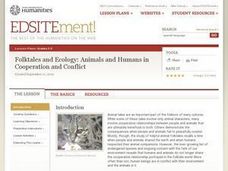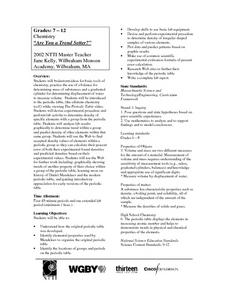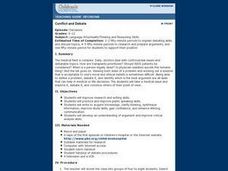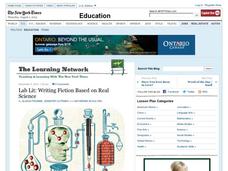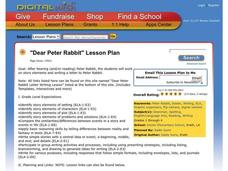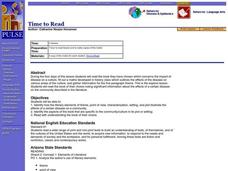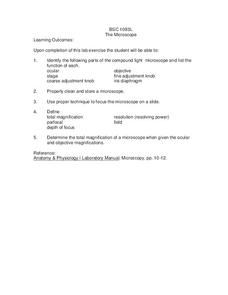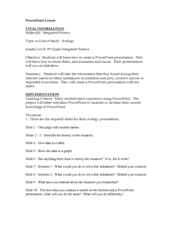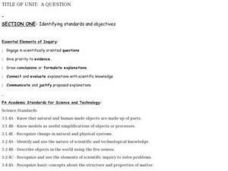NASA
Development of a Model: Analyzing Elemental Abundance
How do scientists identify which elements originate from meteorites? Scholars learn about a sample of material found in a remote location, analyzing the sample to determine if it might be from Earth or not. They study elements, isotopes,...
Curated OER
Folktales and Ecology: Animals and Humans in Cooperation and Conflict
Story elements such as conflict, character analysis, resolution, and moral are discussed and charted as elementary children read folktales involving animals. An element of science is also introduced as learners discover what a keystone...
Curated OER
The Similarities and Differences of Setting
Sixth graders identify components of the setting in science fiction text. In this compare and contrast settings instructional activity, 6th graders read Only You Can Save Mankind and identify similarities and differences between...
Curated OER
What can I do?
Students identify feelings and explore positive ways to handle conflict. In this mental health lesson plan students discuss feelings and how to constructively handle them.
Curated OER
Are You a Trend Setter?
Students are introduced to the periodic table of elements. They devise and perform and experiment in which they determine the density of specific elements. They use their results to predict the density of other elements in the same group.
Curated OER
Conflict and Debate
Students take a medical issue and explore it, debate it, and convince others of their point of view. They improve research skills and writing skills. Students are able to define a problem, debate it, and identify which is the best...
Curated OER
Adventure Writing: Oregon's Landscape as a Setting
Learners identify geographical features of different regions encountered by migrants on the Oregon trail. Students research how the Oregon landscape may have affected life and 19th century westward migration. Learners write a narrative...
Curated OER
Stories of Hope: Dragonfly and Mosquito
Students identify and interpret the value of the dragonfly as a predator of the mosquito. They create their own folktales using the dragonfly or a creature of their choice to solve the malaria problem or another issue. Students also...
Curated OER
LRO and the Apollo-11 Landing Site
In this Apollo-11 landing site worksheet, students read about the NASA Lunar Reconnaissance Orbiter (LRO) that will collect images at a higher resolution than ever before. Students study a grid showing the lunar landing site from Apollo...
Curated OER
Mass Spectrometer
For this mass spectrometer worksheet, students read about how a mass spectrometer determines the elements in gases around Earth. Students answer 3 questions and identify the elements in a graph found by a mass spectrometer.
Curated OER
What Happens in the First Nine Months?
Students identify their feelings and learn constructive ways of handling conflict. For this conflict lesson students discuss their feelings and when they are feeling a certain way what they can do to remedy the situation.
The New York Times
Writing Fiction Based on Real Science - NYTimes.com
Refuse to alienate your scientific-minded young scholars during your creative writing unit. Learners explore how literary writing can reflect observable fact, and be based in actual science. The links include examples of fiction and...
Curated OER
Life's Lessons: Survival of the Fittest
Students analyze Jack London's use of anthropomorphism to identify the importance of adaptability in life. In this literature lesson, students use the novel The Call of the Wild to identify key elements in survival. Students...
Curated OER
Because of Winn Dixie: Water Management Practices
Fourth graders read the book Because of Winn Dixie and define the characters, setting, and plot. In this Winn Dixie lesson plan, 4th graders also identify quality water management techniques addressed in the story.
Curated OER
Dear Peter Rabbit
Write dear old Peter Rabbit a letter with this lesson. First, youngsters listen to the story Peter Rabbit and analyze the story elements. Then they complete a story map graphic organizer in order to write a letter to Peter...
Curated OER
The Social and Economic Impact of Wildlife and Natural Resource Management
Students develop an understanding of environmental laws and regulations. In this research instructional activity, students utilize information that involves controversial issues of wildlife and society.
Curated OER
Is This a House for Hermit Crab?
First graders identify text that uses sequence or other logical order. They identify and interpret how different plants and animals inhabit different kinds of environments and have external features that help them thrive in different...
Curated OER
The Spectrum of a Star
Tenth graders identify stars based on their line spectra. In this astronomy lesson, 10th graders analyze spectrograph and determine the elements present in the star. They explain the relationship between temperature and star classes.
Curated OER
Time to Read
High schoolers identify how the literary elements of theme, point of view, characterization, setting, and plot illustrate the effects of a certain disease on a community. They identify the aspects of the book that are specific to the...
Curated OER
The Microscope
In this microscope lesson students explore the compound light microscope. Students discover techniques concerning cleaning, storage and proper use of the microscope. Students discover the working parts of the compound light microscope as...
Curated OER
Ecology
Students personify ecology vocabulary and write a one-act play using their knowledge of ecology as the basis for characters, conflict, setting and plot.
Curated OER
"Rikki-Tikki-Tavi"
Young scholars explore nature by reading stories in class. For this animal characteristics lesson, students read the story "Rikki-Tikki-Tavi," by Rudyard Kipling and identify the different animals mentioned in the book. Young scholars...
Curated OER
A QUESTION
Young scholars engage in scientifically oriented questions. They give priority to evidence, draw conclusions/formulate explanations and connect/evaluate explanations with scientific knowledge. Students communicate and justify proposed...
Curated OER
2105
Students read excerpts from Jon Scieszka's novel, 2095, prior to presenting their vision of the future in a creative project accompanied by written explanation. They design a museum exhibit which shows a scene from a science fiction book...

